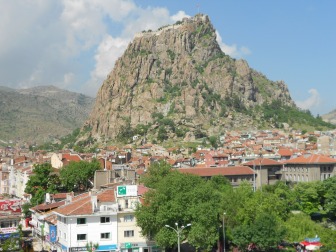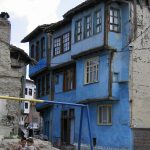Ottoman town at the foot of a rock Population: 187,000
Old name: Akroneos
Afyon (Opium) is the abbreviated name for Afyonkarahisar (Opium Black Castle), a fast-growing town in Western Anatolia on the road from Kütahya (100km) to Konya (235km).
This is where most of Turkey’s legally produced opium comes from and wags always credit the richness of the town’s kaymak (cream) to the fact that the local cows graze on poppy-enriched grass. These days, though, Afyon is almost as well known for the thermal water that supplies a string of resort hotels on the western outskirts of town.
The town huddles around the foot of the karahisar (black castle) after which it is named although since recent restoration the castle now looks more white than black, especially from a distance. Come here at prayer time to hear the sound of the call to prayer ringing out from the town’s many mosques. The original castle appears to date back to Hittite times.
Don’t leave town without: trying thick, tasty local kaymak (cream) and buying a roundel of sucuk (sausage)
Around town
Aside from the castle, Afyon’s single most important attraction is the Ulu Cami which dates back to 1273 and is one of a small group of “forest mosques” whose flat roofs are supported by wooden columns. It’s open daily from 10am to 6pm. The path up to the castle starts from near the mosque. In 2023 the mosque was added to the world heritage list along with four other ‘forest mosques’ at Sivirhisar, Beyşehir, Ankara and Kasaba, near Kastamonu.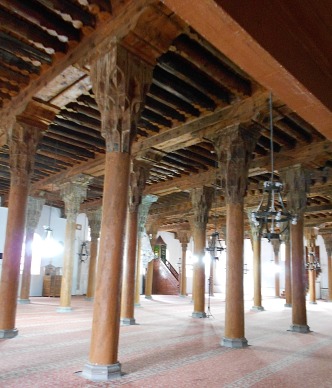
The streets around the Ulu Cami are filled with wonderful Ottoman houses made from wood and stone that were built in the years following a fire that ripped through the area in 1902. Some of them have recently been pleasingly restored. The Şehitoğlu Konağı is open to the public as a show home. Interspersed between the houses are several small neighbourhood mosques, many of them dating back to Selçuk times.
Also in this area is the Mevlevihane Cami, a dervish tekke (lodge) that dates back to the 13th century although the current building is a work of Sultan Abdülhamid II, built in 1908 after the original was destroyed by the fire. Afyon was at one time second in importance only to Konya as a centre for the whirling dervishes because Rumi’s son, Sultan Veled, made it his home. The complex has now been turned into an excellent and well-presented museum showing off the dervish lifestyle and rituals.
A third mosque worth looking out for is the İmaret Cami (Soup Kitchen Mosque) on Bankalar Caddesi, the main road through town. Built in 1472 for the grand vizier Gedik Ahmed Paşa, it was designed in a style that marks the transition from Selçuk to Ottoman architecture with twin domes and two rather unusual side iwans. The adjoining hamam is still in business today while the Taş Medrese (Stone Theological School) in the park beside the mosque was recently restored.
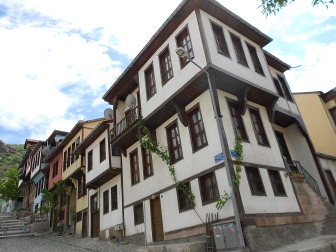 The town’s fine Archaeological Museum (closed Mondays) is worth seeking out. In Roman times, as today, Afyon was an important centre for the mining of marble and it contains many fine marble statues. The museum moved to a new out-of-town site near the Anemon Hotel in 2014. I have yet to see it myself so in the meantime here is the write-up that appeared in Cornucopia magazine. https://www.cornucopia.net/blog/nexus-of-empire/
The town’s fine Archaeological Museum (closed Mondays) is worth seeking out. In Roman times, as today, Afyon was an important centre for the mining of marble and it contains many fine marble statues. The museum moved to a new out-of-town site near the Anemon Hotel in 2014. I have yet to see it myself so in the meantime here is the write-up that appeared in Cornucopia magazine. https://www.cornucopia.net/blog/nexus-of-empire/
Those interested in the battle that took place at nearby Dumlupınar might want to visit the Zafer Müzesi (Victory Museum) housed in the old Hükümet Konağı that once housed the local government. It faces the park in Hükümet Meydanı; access is from the front at weekends but from the back during the week. The paintings that show the vicious hand-to-hand fighting that took place near here are particularly harrowing although the labelling is in Turkish only.
Anemon Hotel. Tel: 0272-246 3636
İkbal Termal Otel. Tel: 0272-252 5600
Grand Ozer Termal Otel. Tel: 0272-214 3300
Eating
In the town centre opposite the covered market the brightly lit İkbal Lokantası has been dishing up good food to locals since 1922. A great selection of soups, stews and kebabs can be followed with one of the tasty desserts on display in a glass case – the vişneli ekmek kadayıf, a cherry-flavoured sponge dessert, is especially delicious with the thick, chewy local kaymak (cream).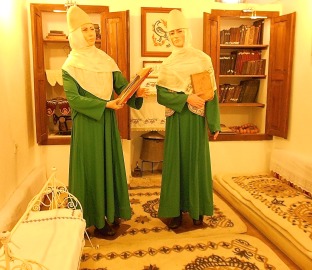 Mannequins of female dervishes in Mevlevi Museum
Mannequins of female dervishes in Mevlevi Museum
Transport info
The nearest airport to Afyon is Kütahya‘s Zafer Airport (KZR), 61km from the town centre.
There are regular buses to Afyon from Ankara, Konya, Isparta, Uşak and Eskişehir.
The Otogar (Yeni Garaj) is out towards the thermal hotels and features glass-fronted booths in which locals in white overalls and face masks churn out pişmaniye, köme and other favourite Turkish sweets. This is all very well but it’s hardly the most convenient location – and it hardly helps that the Köy Garaj from which local services depart is in another equally remote location.
Free servis buses to the Otogar are marked “Otogar Yolcu Servisi”. Otherwise an army of buses and minibuses from in front of the Zafer Museum also serve the Otogar while buses to Sahipata serve the Köy Garaj.
Forget the Eski Garaj (Old Terminal) – it no longer has anything to do with transport.
A Kentcard is required to pay for bus services.
Day trip destinations
Read more about Afyon:A Tale of Two Afyons
Read more about a famous Afyon restaurant: http://www.turkeyfromtheinside.com/blogbloggingaboutturkey/entry/39-remembering-the-war.html
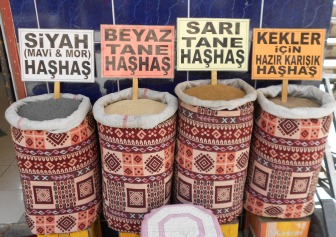 Black, white and yellow poppy seeds for sale in the market
Black, white and yellow poppy seeds for sale in the market
